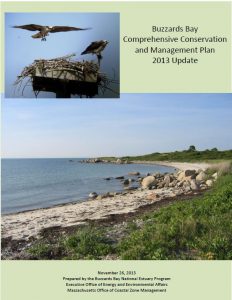2013 CCMP, Action Plan 13:
Protecting and Restoring Ponds and Streams
About the new Buzzards Bay CCMP Action Plans
The Buzzards Bay Comprehensive Conservation and Management Plan (CCMP) was updated in November 2013 to reflect the great progress achieved since the original CCMP was finalized. You can download the entire document (buzzards-bay-ccmp-2013-update.pdf) or just this action plan Protecting and Restoring Ponds and Streams.
Protecting Ponds and Streams
Problem
Many rivers and ponds in the Buzzards Bay watershed are impaired because of toxic contaminants, bacteria, nutrients, sediments, nuisance species, temperature changes, barriers to fish migration, water withdrawals, alterations of flow, and other problems. The Massachusetts Department of Environmental Protection (DEP) reports these impairments to the U.S. EPA as required by the Clean Water Act, in its “Integrated List of Waters” reports. These integrated lists classify bodies of waters into different categories. For example, Category 5 waters are impaired, and Category 3 waters are unassessed. As shown in Table 45, these impaired freshwaters (Category 5) total 959.8 acres (of the 4,376 acres listed) and 16.0 linear miles of streams (of the 64.9 miles listed).
To restore these waters will require considerable effort. The Clean Water Act requires that states identify those waterbodies that are not expected to meet surface water quality standards after the implementation of technology-based controls and to prioritize and schedule them for the development of a total maximum daily load (TMDL). These TMDLs establish the maximum amount of a pollutant that may be introduced into a water body and still ensure attainment and maintenance of water quality standards. TMDLs and restoration of these bodies of waters may require a local watershed plan. The effort to characterize and assess all these bodies of water, and to restore impaired ones, represents an immense challenge to both local and state managers.
Goal
Goal 13.1. Ensure that beneficial water uses will not be lost, nor ecosystems adversely affected, by pollution discharges, nuisance species, or alterations of flow to fresh surface waters in the Buzzards Bay watershed.
Goal 13.2. Restore any beneficial water uses and ecosystem functions lost in watershed freshwater systems caused by pollution discharges, nuisance species, or alterations of flow and volume.
Objectives
Objective 13.1. Help adopt TMDLs for all freshwaters.
Objective 13.2. Help ensure that plans are developed and implemented to meet recommended TMDLs.
Objective 13.3. Help restore impaired wetlands habitat.
Objective 13.4. Protect open space that enhances and protects lakes, ponds, and streams.
Approaches
This action plan requires complying with the Clean Water Act. To achieve its goal, pollution sources in the watershed of each impaired body must be characterized, and where appropriate, a site-specific TMDL adopted. This is complex, and an immense task, because dozens of local subwatershed plans need to be developed. More-over, many bodies of waters and tributary segments have never been assessed, so the scope of the environmental challenge remains unresolved.
DEP will need to develop TMDLs for each impaired water body identified on the 303(d) and Integrated Lists in a timely way. Similarly, DEP will need to evaluate eventually all unassessed waters (those not included on the integrated list).
Despite these challenges and prolonged timeline, and the lack of funds and staffing to solve this problem, municipalities should establish local priorities and implement common sense measures to reduce existing im-pairments. Municipalities should establish water quality task forces for priority freshwater systems and have these workgroups develop management strategies. Municipal legislative bodies (town meeting or city council) should authorize new funding to evaluate and develop priorities for restoration, and to implement specific remedial actions, like treating or eliminating stormwater discharges. Interested residents should become involved in protecting and monitoring these freshwater systems. Local laws and regulations are also needed to reduce the impacts of new development and to prevent new im-pairments.
Costs and Financing
The development of watershed characterizations, local watershed plans, and TMDLs for impaired waters, all have substantial costs (possibly millions over a decade). State, federal, and local government must all contribute. Costs that are more substantial will be borne by local government and property owners, and state and federal government funds could leverage action.
Measuring Success
The percent of systems impaired, the total number of impaired systems, and the percent of unimpaired systems are all key measures for tracking progress towards the goals of this action plan. Development of local watershed plans and strategies; TMDLs, and number of systems removed from the impaired waters list are other metrics for tracking progress.
Additional Background
The percent of systems impaired, the total number of impaired systems, and the percent of unimpaired systems are all key measures for tracking progress towards the goals of this action plan. Development of subwatershed plans and strategies; TMDLs, and number of systems removed from the impaired waters list are other metrics for tracking progress.
(*) Beneficial uses are those listed in Massachusetts Water Quality Standards, see entry in Glossary.
